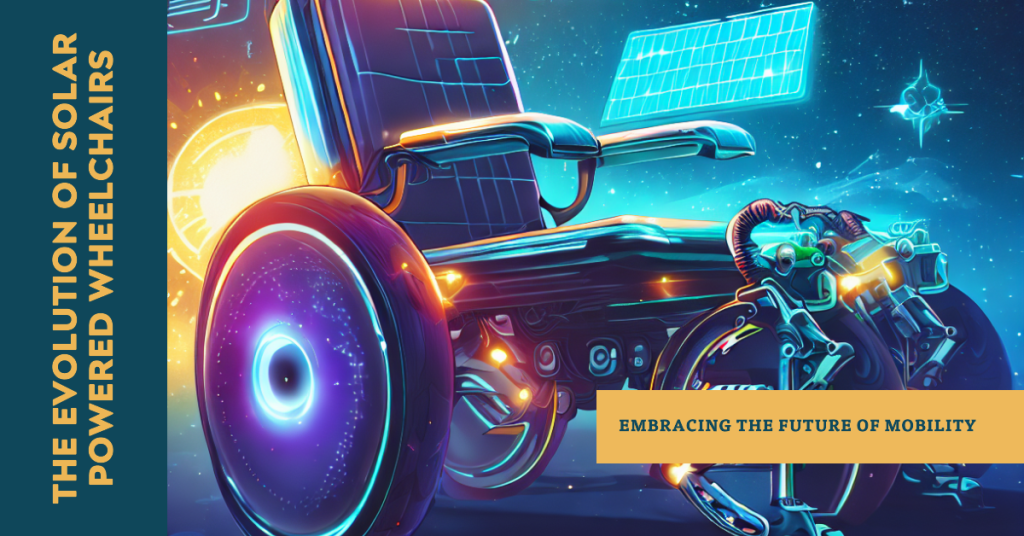Hey, we’ve all been there. You’re out and about, enjoying your day, and then it happens. Your wheelchair beeps that dreaded low-battery warning. Panic sets in. Will you make it home? On hot sunny days, wouldn’t it be good to charge as you go along and for free?
Welcome to the exciting world of solar-powered wheelchairs! This article aims to take you on a journey through the evolution of these innovative mobility devices. From early prototypes to DIY solutions, and finally, to a product you can actually buy, we’ll explore how solar-powered wheelchairs are changing the game for eco-friendly mobility. Let’s dive in!
The Current State of Battery-Powered Wheelchairs
Battery-powered wheelchairs are great, but they have their limits. Charging takes time, and you always need to end the day near a power outlet.
| Battery Type | Charging Time | Range |
|---|---|---|
| Lead Acid | 8-12 hours | 10-20 miles |
| Lithium-ion | 2-4 hours | 15-25 miles |
The Dream of Solar-Powered Wheelchairs
The idea of a solar-powered wheelchair isn’t new. In fact, it captured imaginations as early as 2012 when a team from the University of Virginia created a prototype. This wheelchair featured retractable solar panels and even won the World Cerebral Palsy Day Competition. It was a glimpse into what could be possible, blending sustainability with mobility.
This prototype was more than just a tech demo; it was a vision of a future where wheelchairs could be both eco-friendly and functional. The wheelchair could stay cruising with no additional back up power other than the sun, as long as it was a bright day!
DIY Solar Solutions to Power Your Wheelchair
While waiting for market-ready solar-powered wheelchairs, some have taken matters into their own hands. Zach Anner, for example, shows us how to convert an existing wheelchair into a solar-powered one. With just a solar panel, a battery, and a power inverter, you can extend your wheelchair’s battery life by charging whenever you are stationary and away from a power source and reduce your carbon footprint.
This DIY approach is not just a stopgap but a viable solution for those eager to embrace solar power now. Next, we’ll look at a solar-powered wheelchair you can actually buy today.
The Liberator: A Dream Realised
Good news for those who’ve been waiting: the future is here! The Liberator by Solar Mobility is the first solar power-assisted wheelchair available for purchase.

This isn’t just a wheelchair; it’s a leap forward in sustainable mobility. Here’s what sets it apart:
- Solar Companion Panel: Keeps your battery constantly charged.
- Active Seat Ventilation: Provides comfort by reducing moisture and improving airflow.
- Colour-Coded LED Lights: Enhances safety during both day and night rides.
- Price: $12,600, marked down from $16,758.
Product Link: Liberator Solar Power Assisted Wheelchair
The Liberator makes the dream of a solar-powered wheelchair a reality. It combines innovation, comfort, and sustainability in one package. In our conclusion, we’ll wrap up this journey from prototypes to a product you can own.
The Future of Solar Powered Wheelchairs
We’ve explored the journey from early solar-powered wheelchair concepts to DIY hacks, and now to an actual product you can buy—The Liberator. While this marks progress, it’s crucial to note the limitations. Solar panels need to be large for effectiveness, and in less sunny climates like the UK, relying solely on solar power may not be practical.
The development of solar-powered wheelchairs shows promise but also highlights the challenges of making solar energy both efficient and universally adaptable. Whether you’re considering a DIY solar project or thinking about the Liberator, it’s clear that while strides have been made, there’s still work to be done in making solar-powered wheelchairs a reliable option.
Further reading and research about solar powered wheelchairs
Here are some interesting articles about research on solar-powered wheelchairs:
1. “Solar-powered wheelchairs for physically challenged people“: This article discusses the benefits of solar-powered wheelchairs and how they can help people with disabilities be more independent.
2. “Design and fabrication of solar powered wheelchair“: This paper describes the design and fabrication of a solar-powered wheelchair that is semi-automated using sensors and can be controlled using a joystick.
3. “Literature Review on Solar Powered Wheelchairs“: This literature review provides an overview of the research that has been done on solar-powered wheelchairs, including their design, performance, and cost-effectiveness.
4. “A Study on Low Cost Solar Powered Wheel Chair for Disabled People of Bangladesh“: This paper presents a study on a low-cost solar-powered wheelchair for disabled people in Bangladesh, including the design of the wheelchair structure, motor, and solar panel.
5. “Design and Manufacture of Solar-Powered Wheelchair“: This paper describes the design and manufacture of a low-cost solar-powered wheelchair for disabled people in rural areas of South Africa.
6. “Design and development of solar power-assisted manual/electric wheelchair“: This study aimed to design and develop a solar power-assisted electric wheelchair featuring a switch enabling the user to choose between manual and electric propulsion mode and a quick release mechanism for the batteries and solar panels.
Overall, these articles demonstrate that solar-powered wheelchairs are a promising technology that can help people with disabilities be more independent and mobile. They also highlight the importance of designing low-cost and efficient systems that can be easily maintained and repaired.

